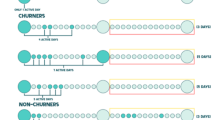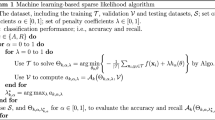Abstract
Marketers have long since understood the importance of customer segmentation and customer churn prediction modelling. However, linking these processes remains a challenge. Customer segmentation is often performed by applying a clustering algorithm on customer behavioral data, which is another challenging task since datasets on customer behavior typically comprise mixed-data types. This research focuses on clustering player behavior data for churn prediction modelling in the mobile games market and constructing a dissimilarity measure capable of simultaneously handling categorical and quantitative data. The problem of finding an appropriate dissimilarity measure for mixed-type data with unbalanced categorical features and highly skewed numerical features is handled by establishing a hybrid dissimilarity measure constructed as a normalized linear combination of distances. Distances are calculated conditional on feature type following the principles of Gower’s coefficient calculation where for numerical features, distances are calculated by applying a modified winsorized Huber loss, while for categorical features, we incorporate a distance measure based on variable entropy. In conjunction with the PAM clustering algorithm, the established dissimilarity measure is applied on real-world datasets and the performance is compared to several state-of-the-art clustering algorithms. Secondly, this research investigates the potential of customer segmentation as an integral part of churn prediction modelling in online games which is operationalized by applying the proposed clustering method on a real dataset comprising mixed-type data originating from a casual mobile game. The benefits of customer segmentation are supported by the data since churn prediction models exhibit higher performance when the clustering is performed prior to churn classification.




Source: Own work

Source: Own work


Source Own work.

Source Own work.
Similar content being viewed by others
Data availability
The datasets analysed during the current study are not publicly available due to confidentiality.
Code availability
The software application or custom code is not publicly available.
References
Ahmad A, Dey L (2007) A k-mean clustering algorithm for mixed numeric and categorical data. Data Knowl Eng. https://doi.org/10.1016/j.datak.2007.03.016
Ahmad A, Khan SS (2019) Survey of state-of-the-art mixed data clustering algorithms. IEEE Access. https://doi.org/10.1109/ACCESS.2019.2903568
Bauckhage C, Drachen A, Sifa R (2015) Clustering game behavior data. IEEE Trans Comput Intell AI Games. https://doi.org/10.1109/TCIAIG.2014.2376982
Behzadi S, Müller NS, Plant C, Böhm C (2020) Clustering of mixed-type data considering concept hierarchies: problem specification and algorithm. Int J Data Sci Analyt. https://doi.org/10.1007/s41060-020-00216-2
Boriah S, Chandola V, Kumar V (2008) Similarity measures for categorical data: A comparative evaluation. Society for industrial and applied mathematics - 8th SIAM International conference on data mining 2008, proceedings in applied mathematics 130. https://doi.org/10.1137/1.9781611972788.22
Budiaji W, Leisch F (2019) Simple k-medoids partitioning algorithm for mixed variable data. Algorithms. https://doi.org/10.3390/a12090177
Castro EG, Tsuzuki MSG (2015) Churn prediction in online games using players’ login records: a frequency analysis approach. IEEE Trans Computat Intell AI Games. https://doi.org/10.1109/TCIAIG.2015.2401979
D’Urso P, Massari R (2019) Fuzzy clustering of mixed data. Inf Sci. https://doi.org/10.1016/j.ins.2019.07.100
de Amorim RC, Makarenkov V (2016) Applying subclustering and Lp distance in Weighted K-Means with distributed centroids. Neurocomputing. https://doi.org/10.1016/j.neucom.2015.08.018
Dinh DT, Huynh VN, Sriboonchitta S (2021) Clustering mixed numerical and categorical data with missing values. Inf Sci 571:418–442. https://doi.org/10.1016/J.INS.2021.04.076
Dos Santos TRL, Zárate LE (2015) Categorical data clustering: what similarity measure to recommend? Expert Syst Appl. https://doi.org/10.1016/j.eswa.2014.09.012
Drachen A, Connor S (2018) Game analytics for games user research. Games User Res. https://doi.org/10.1093/oso/9780198794844.003.0019
Drachen A, Mirza-Babaei P, Nacke LE (2018) Frontlines in games user research. Games User Res. https://doi.org/10.1093/oso/9780198794844.003.0031
Dua D, Graff C (2019) UCI Machine Learning repository: data sets. University of California, School of Information and Computer Science, Irvine, CA
Foss A, Markatou M, Ray B, Heching A (2016) A semiparametric method for clustering mixed data. Machine Learn. https://doi.org/10.1007/s10994-016-5575-7
Foss AH, Markatou M, Ray B (2019) Distance metrics and clustering methods for mixed-type data. Int Stat Rev. https://doi.org/10.1111/insr.12274
Fu X, Chen X, Shi YT, Bose I, Cai S (2017) User segmentation for retention management in online social games. Decis Support Syst. https://doi.org/10.1016/j.dss.2017.05.015
Gagné AR, El-Nasr MS, Shaw CD (2011) A deeper look at the use of telemetry for analysis of player behavior in RTS Games. Lecture notes in computer science (including subseries lecture notes in artificial intelligence and lecture notes in bioinformatics). https://doi.org/10.1007/978-3-642-24500-8_26
Gower JC (1971) A general coefficient of similarity and some of its properties. Biometrics. https://doi.org/10.2307/2528823
Hadiji F, Sifa R, Drachen A, Thurau C, Kersting K, Bauckhage C (2014). Predicting player churn in the wild. IEEE Conference on computatonal intelligence and games, CIG. https://doi.org/10.1109/CIG.2014.6932876
Hamka F, Bouwman H, De Reuver M, Kroesen M (2014) Mobile customer segmentation based on smartphone measurement. Telemat Inform. https://doi.org/10.1016/j.tele.2013.08.006
Hashmi N, Butt NA, Iqbal M (2013) Customer churn prediction in telecommunication: a decade review and classification. IJCSI International journal of computer science issues
Hastie T, Tibshirani R, Friedman J (2009) Elements of Statistical Learning 2nd ed. In Elements. https://doi.org/10.1007/978-0-387-84858-7
Hsu CC, Lin SH, Tai WS (2011) Apply extended self-organizing map to cluster and classify mixed-type data. Neurocomputing 74(18):3832–3842. https://doi.org/10.1016/J.NEUCOM.2011.07.014
Hu YH, Huang TCK, Kao YH (2013) Knowledge discovery of weighted RFM sequential patterns from customer sequence databases. J Syst Softw. https://doi.org/10.1016/j.jss.2012.11.016
Huang Z (1997) Clustering large data sets with mixed numeric and categorical values. Proceedings of the 1st pacific-asia conference on knowledge discovery and data mining,(PAKDD).
Huber PJ (1964) Robust estimation of a location parameter. Ann Math Stat. https://doi.org/10.1214/aoms/1177703732
Hubert L, Arabie P (1985) Comparing partitions. J Classif. https://doi.org/10.1007/BF01908075
Jia Z, Song L (2020) Weighted k-prototypes clustering algorithm based on the hybrid dissimilarity coefficient. Math Probl Eng. https://doi.org/10.1155/2020/5143797
Karnstedt M, Hennessy T, Chan J, Basuchowdhuri P, Hayes C, Strufe T (2010) Churn in social networks. Handb Social Netw Tech Appl. https://doi.org/10.1007/978-1-4419-7142-5_9
Kaufman L, Rousseeuw PJ (1990) Finding groups in data: an introduction to cluster analysis (Wiley Series in Probability and Statistics) In Eepe.Ethz.Ch
Kim S, Choi D, Lee E, Rhee W (2017) Churn prediction of mobile and online casual games using play log data. PLoS ONE. https://doi.org/10.1371/journal.pone.0180735
Kumar V, Chhabra JK, Kumar D (2014) Performance evaluation of distance metrics in the clustering algorithms. INFOCOMP J Comput Sci 13(1):38–52
Loria E, Marconi A (2021) Exploiting limited players’ behavioral data to predict churn in gamification. Electron Commer Res Appl. https://doi.org/10.1016/j.elerap.2021.101057
Maechler M, Struyf A, Hubert M, Hornik K, Studer M, Roudier P (2019) Cluster: cluster analysis basics and extensions. In R package version 2.1.0
Mori U, Mendiburu A, Lozano JA (2016) Similarity measure selection for clustering time series databases. IEEE Trans Knowl Data Eng. https://doi.org/10.1109/TKDE.2015.2462369
Mutazinda H, Sowjanya M, Mrudula O (2015) Cluster ensemble approach for clustering mixed data. Int J Comput Tech 2(5):43–51
Perišić A, Pahor M (2021) RFM-LIR feature framework for churn prediction in the mobile games market. IEEE Trans Games. https://doi.org/10.1109/TG.2021.3067114
Perišić A, Šišak Jung D, Pahor M (2022) Churn in the mobile gaming field: establishing churn definitions and measuring classification similarities. Expert Syst Appl 191:116277. https://doi.org/10.1016/j.eswa.2021.116277
Perisic A, Pahor M (2020) Extended RFM logit model for churn prediction in the mobile gaming market. Croat Operat Res Rev, https://doi.org/10.17535/crorr.2020.0020
Reddy J, Kavitha B (2012) Clustering the mixed numerical and categorical datasets using similarity weight and filter method. Int J Datab Theory Appl 5(1):121–134
Rothmeier K, Pflanzl N, Hullmann JA, Preuss M (2021) Prediction of player churn and disengagement based on user activity data of a freemium online strategy game. IEEE Trans Games. https://doi.org/10.1109/TG.2020.2992282
Rousseeuw PJ (1987) Silhouettes: a graphical aid to the interpretation and validation of cluster analysis. J Comput Appl Math. https://doi.org/10.1016/0377-0427(87)90125-7
Runge J, Gao P, Garcin F, Faltings B (2014) Churn prediction for high-value players in casual social games. IEEE Conference on Computatonal Intelligence and Games, CIG. https://doi.org/10.1109/CIG.2014.6932875
Sangam RS, Om H (2018) An equi-biased k-prototypes algorithm for clustering mixed-type data. Sadhana - Academy proceedings in engineering sciences. https://doi.org/10.1007/s12046-018-0823-0
Schubert E, Rousseeuw PJ (2019) Faster k-Medoids Clustering: improving the PAM, CLARA, and CLARANS Algorithms. Lecture notes in computer science (Including subseries lecture notes in artificial intelligence and lecture notes in bioinformatics). https://doi.org/10.1007/978-3-030-32047-8_16
Seal A, Karlekar A, Krejcar O, Gonzalo-Martin C (2020) Fuzzy c-means clustering using Jeffreys-divergence based similarity measure. Appl Soft Comput J. https://doi.org/10.1016/j.asoc.2019.106016
Sharma KK, Seal A (2021a) Multi-view spectral clustering for uncertain objects. Inf Sci. https://doi.org/10.1016/j.ins.2020.08.080
Sharma KK, Seal A (2021b) Outlier-robust multi-view clustering for uncertain data. Knowl-Based Syst. https://doi.org/10.1016/j.knosys.2020.106567
Sifa R, Drachen A, Bauckhage C (2018) Profiling in games: understanding behavior from telemetry. Soci Interact Virt World. https://doi.org/10.1017/9781316422823.014
Smith WR (1956) Product differentiation and market segmentation as alternative marketing strategies. J Mark. https://doi.org/10.2307/1247695
Strobl C, Boulesteix AL, Zeileis A, Hothorn T (2007) Bias in random forest variable importance measures: illustrations, sources and a solution. BMC Bioinfor. https://doi.org/10.1186/1471-2105-8-25
Strobl C, Boulesteix AL, Kneib T, Augustin T, Zeileis A (2008) Conditional variable importance for random forests. BMC Bioinfor. https://doi.org/10.1186/1471-2105-9-307
Strobl C, Hothorn T, Zeileis A (2009) Party on! R J. https://doi.org/10.32614/rj-2009-013
Šulc, Zdenek, Prochazka, J., & Matejka, M. (2016). Modifications of the Gower similarity coefficient. The 19th Conference of Applications of Mathematics and Statistics in Economics,.
Zdeněk Š, Matějka, M., Procházka, J., & Řezanková, H. (2017). Evaluation of the Gower coefficient modifications in hierarchical clustering. Metodoloski Zvezki.
Šulc Z, Řezanková H (2019) Comparison of similarity measures for categorical data in hierarchical clustering. J Classif. https://doi.org/10.1007/s00357-019-09317-5
Ullah I, Raza B, Malik AK, Imran M, Islam SU, Kim SW (2019) A churn prediction model using random forest: analysis of machine learning techniques for churn prediction and factor identification in telecom sector. IEEE Access. https://doi.org/10.1109/ACCESS.2019.2914999
van de Velden M, Iodice D’Enza A, Markos A (2019) Distance-based clustering of mixed data. Wiley Interdisciplinary Reviews: Computational Statistics. https://doi.org/10.1002/wics.1456
Verbeke W, Martens D, Mues C, Baesens B (2011) Building comprehensible customer churn prediction models with advanced rule induction techniques. Expert Syst Appl. https://doi.org/10.1016/j.eswa.2010.08.023
Zhang P, Wang X, Song PXK (2006) Clustering categorical data based on distance vectors. J Am Stat Assoc. https://doi.org/10.1198/016214505000000312
Zhou J, Zhai L, Pantelous AA (2020) Market segmentation using high-dimensional sparse consumers data. Expert Syst Appl. https://doi.org/10.1016/j.eswa.2019.113136
Zhu X, Li Y, Wang J, Zheng T, Fu J (2021) Automatic Recommendation of a Distance Measure for Clustering Algorithms. ACM Trans Knowl Discov Data. https://doi.org/10.1145/3418228
Funding
This research received no specific grant from any funding agency in the public, commercial, or not-for-profit sectors.
Author information
Authors and Affiliations
Contributions
AP: Conceptualization, Methodology, Software, Validation, Formal analysis, Data curation, Writing – Original draft, Writing – Review & Editing, Visualization. MP: Supervision, Writing – Review & Editing.
Corresponding author
Ethics declarations
Conflict of interest
The authors declare that they have no conflict of interests.
Informed consent
The majority of this research is conducted as a part of a PhD Thesis at University of Ljubljana, Slovenia, within the area of building churn prediction models for the online gaming market.
Additional information
Publisher's Note
Springer Nature remains neutral with regard to jurisdictional claims in published maps and institutional affiliations.
Rights and permissions
About this article
Cite this article
Perišić, A., Pahor, M. Clustering mixed-type player behavior data for churn prediction in mobile games. Cent Eur J Oper Res 31, 165–190 (2023). https://doi.org/10.1007/s10100-022-00802-8
Accepted:
Published:
Issue Date:
DOI: https://doi.org/10.1007/s10100-022-00802-8




